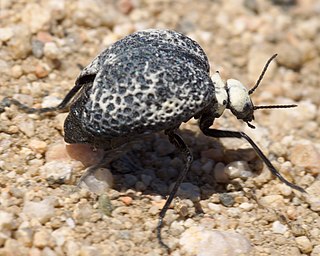
Darkling beetle is the common name for members of the beetle family Tenebrionidae, comprising over 20,000 species in a cosmopolitan distribution.

Harpalinae is the largest subfamily of ground beetles, containing more than 19,000 species worldwide.

Tenebrio obscurus, or the dark mealworm beetle, is a species of darkling beetle whose larvae are known as mini mealworms. These insects should not be confused with younger mealworms or with the confused flour beetle.

Flour beetles are members of several darkling beetle genera including Tribolium and Tenebrio. They are pests of cereal silos and are widely used as laboratory animals, as they are easy to keep. The flour beetles consume wheat and other grains, are adapted to survive in very dry environments, and can withstand even higher amounts of radiation than cockroaches.

Eleodes is a genus of darkling beetles, in the family Tenebrionidae. They are endemic to western North America ranging from southern Canada to central Mexico with many species found along the Mexico-United States border. Some species have been introduced to Colombia. The name pinacate is Mexican Spanish, derived from the Nahuatl (Aztec) name for the insect, pinacatl, which translates as "black beetle".

The confused flour beetle, a type of darkling beetle known as a flour beetle, is a globally found, common pest insect known for attacking and infesting stored flour and grain. They are one of the most common and most destructive insect pests for grain and other food products stored in silos, warehouses, grocery stores, and homes. They engage in cannibalistic behaviors for population control and nutritional benefits. Tribolium confusum practices kin selection to improve individual fitness. Multiple chemicals have been used to manage their infestation, including pyrethin and fungal insecticides.

Tenebrioninae is the largest subfamily of the darkling beetles (Tenebrionidae), containing flour beetles, among others. Tenebrioninae contains more than 20 tribes.

The red flour beetle is a species of beetle in the family Tenebrionidae, the darkling beetles. The red flour beetle, and other closely related beetles like Gnatocerus cornutus, are a worldwide pest of stored products, particularly food grains, and a model organism for ethological and food safety research.
Alexander Sokoloff was a biologist and geneticist who conducted genetic research on the red flour beetle Tribolium castaneum, a world-wide pest species. From 1965 to 1990 he was a Professor of Biology at California State University, San Bernardino, serving for part of that time as Department Chair.
Acarophenacidae is a family of mites in the order Trombidiformes that are egg parasitoids and ectoparasites of beetles or thrips. It contains eight genera and around 40 species.

Tribolium is a genus of flour beetles in the family Tenebrionidae. They are known by various common names including flour beetles, flour weevils, red weevils and bran bugs.

Epitragini is a tribe of darkling beetles in the subfamily Pimeliinae of the family Tenebrionidae. There are more than 30 genera in Epitragini, found in the North, Central, and South America.

Triboliini is a tribe of darkling beetles in the family Tenebrionidae. There are about 10 genera in Triboliini.

Eupomphini is a tribe of blister beetles in the family Meloidae. There are about 7 genera and more than 20 described species in Eupomphini.
Pontomalota is a genus of "sea shore genera" in the beetle family Staphylinidae. There are at least two described species in Pontomalota.
Rhadine caudata is a species of beetle native to the eastern United States. It is a brachypterous habitat specialist, occurring in only two of five forest classes in a North Carolina study. R. caudata is a considered a Vulnerable species at the global level on NatureServe, Imperiled in Alabama, and Vulnerable in Virginia.

Coelocnemis is a genus of darkling beetles in the family Tenebrionidae. There are about seven described species in Coelocnemis, found mainly in western Canada, western United States, and Mexico.
Aphanotus is a genus of darkling beetles in the family Tenebrionidae. Species in this genus were previously within Tribolium but placed in the genus Aphanotus following phylogenetic evidence.
Metoponium is a North American genus of darkling beetles.

Argoporis is a genus of darkling beetles in the family Tenebrionidae. There are more than 20 described species in Argoporis. They are found in North America.











